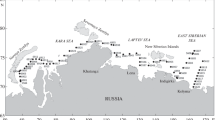Summary
Spatial distribution of picoplankton in the Ross Sea was studied. The authors discuss the biomasses of various picoplanktonic-sized fractions and of bacterial cells between 0.2 and 2.0 μm capable of growing on Marine Agar 2216 (Difco). Picoplankton having a cellular diameter cf between 1.0 and 2.0 μm (PP1) generally predominate, accounting for 73% of the whole picoplankton biomass. However, smaller cells (PP2) can represent 28% of the picoplankton biomass at depths corresponding to 1% of surface light. These results are in good agreement with those found in the coastal regions of McMurdo Sound (Fuhrman and Azam 1980) and in other areas of the Antarctic seas where total bacterioplankton was studied (Hanson et al. 1983b; El-Sayed 1987; Lancelot et al. 1989). Biomasses of total picoplankton (TPP) are not correlated with any of the environmental parameters studied. The PP1 is correlated with O2 and silicates and PP2 is correlated with O2, phosphates temperature and nitrates. Aerobic heterotrophic biomasses are correlated with O2 and salinity.
Similar content being viewed by others
References
Acosta Pomar MLC (1989) Ecologia e distribuzione del picoplancton in ambiente marino e salmastro. Tesi di Dottorato in Scienze Ambientali: Ambiente marino e Risorse, pp 1–156
Acosta Pomar MLC, Maugeri TL, (1990) Distribuzione del picoplancton — totale e fotosintetico — in due aree del Mediterraneo. Oebalia [Suppl] 16–1:427–441
Azam F, Beers JR, Holm-Hansen O, Reid FMH, Karl DM (1979) Occurrence and metabolic activity of organisms under the Ross Ice Shelf, Antarctica, at station 19. Science 203:451–453
Bruni V, Magazzù G, Maugeri TL, Acosta Pomar MLC, Decembrini F (1989) Ulteriori indagini sul picofitoplancton dei mari italiani. SITE ATTI 7:101–107
Bruni V, Maugeri TL, Acosta Pomar MLC, Grasso S, Moio L (1990) Primi dati sulla microflora marina nella Baia Terra Nova (Oceano Antartico). Nat Sci Cpm Ant Ocean Camp 1987–88. Data Rep I:87–104
Ducklow HW, Purdie DA, Williams PJ leB (1987) Bacteria: link or sink?. Science 235:88–89
El Sayed SZ (1987) Biological productivity of Antarctic waters: present paradoxes and emerging paradigms. BIOMASS Sci, Antarct Aquat Biol 7:1–21
Fogg GE (1986a) Picoplankton. Proc R Soc London, Ser B 228:1–30
Fuhrman JA (1981) Influence of method on the apparent size distribution of bacterioplankton cells: epifluorescence microscopy compared to scanning electron microscopy. Mar Ecol Prog Ser 5:103–106
Fuhrman JA, Azam F (1980) Bacterioplankton secondary production estimates for coastal waters of British Columbia, Antarctica and California. Appl Environ Microbiol 39:1085–1095
Fuhrman JA, Azam F (1982) Thymidine incorporation as a measure of heterotrophic bacterioplankton production in marine surface waters: evaluation and field results. Mar Biol 66:109–120
Hanson RB, Lowery HK, Shafer D, Sorocco R, Pope DH (1983a) Microbes in Antarctic water of Drake Passage: vertical patterns of substrate uptake, productivity and biomass in January 1980. Polar Biol 2:179–188
Hanson RB, Shafer D, Ryan T, Pope DH, Lowery HK (1983b) Bacterioplankton in Antarctic Ocean waters during late Austral winter: abundance, frequency of dividing cells and estimates of production. Appl Environ Microbiol 45:1622–1632
Harrison WG, Li WKW, Smith JC, Head EJH, Longhurst AR (1987) Depth profiles of plankton, particulate organic matter and microbial activity in the Eastern Canadian Arctic during summer. Polar Biol 7:207–224
Hodson RE, Azam F, Carlucci AF, Furhman JA, Karl DM, Holm-Hansen O (1981) Microbial uptake of dissolved organic matter in Mc Murdo Sound, Antarctica. Mar Biol 61:89–94
Holm-Hansen O, Azam F, Carlucci AF, Hodson RE, Karl DM (1977) Microbial distribution and activity in and around Mc Murdo Sound Antarctic. J US 12:29–32
Joint IR, Morris RJ (1982) The role of bacteria in the turnover of organic matter in the sea. Oceanogr Mar Biol Annu Rev 20:65–118
Lancelot Ch, Billen G, Mathot S (1989) Ecophysiology of phytoplankton growth in the Southern Ocean. In: Antarctic, Belgian Scientific Research Programme I. Plankt Ecol pp 1–92
Marchant HJ, Davidson T, Wright W (1987) The distribution and abundance of Chroococcoid Cyanobacteria in the Southern Ocean. Proc NIPR Symp Polar Biol 1:1–9
Maugeri TL, Acosta Pomar MLC, Bruni V (1990) II Picoplancton. In: Innamorati M, Ferrari I, Marino D, Ribera D'Alcala M, (eds) Metodi nella ecologia del plancton marino. Nova Thalassia 11:199–205
Maugeri TL, Bruni V, Acosta Pomar MLC (1991) On the characteristics of the microflora in the Terra Nova Bay waters (Antarctica). Microbiologica 14:55–64
Satoh H, Fukami K, Watanabe K, Takahashi E (1989) Seasonal change in heterotrophic bacteria under fast ice near Syowa station, Antarctica. Can J Microbiol 35:329–333
Sherr EB, Sherr BF, Albright LJ (1987) Link or sink. Science 235:88
Sieburth J Mc (1979) Sea microbes. Oxford, Univ New York
Sieburth J Mc, Davis PG (1982) The role of heterotrophic nanoplankton on the grazing and nuturing of the planktonic bacteria in the Sargasso and Caribbean Seas. Ann Inst Oceanogr Paris 58:285–296
Van Es FB, Meyer-Reil LA (1982) Biomass and metabolic activity of heterotrophic marine bacteria. Adv Microbiol Ecol 6:111–170
Watson FW, Novitsky TS, Quinby IC, Valois FW (1977) Determination of bacterial number and biomass in the marine environment. Appl Environ Microbiol 104:7–13
Williams PJ leB. (1984) A revue of measurements of respiration rate of marine plankton population. In: Hobbie JE and Williams PJ leB (eds) Heterotrophic activity in the sea. 357–390.




